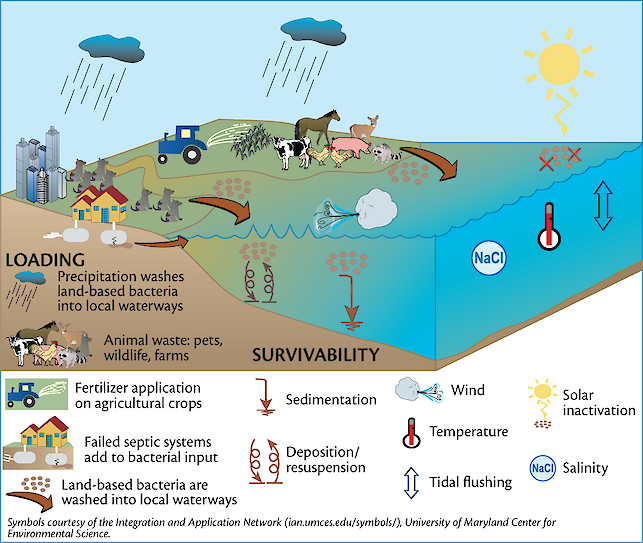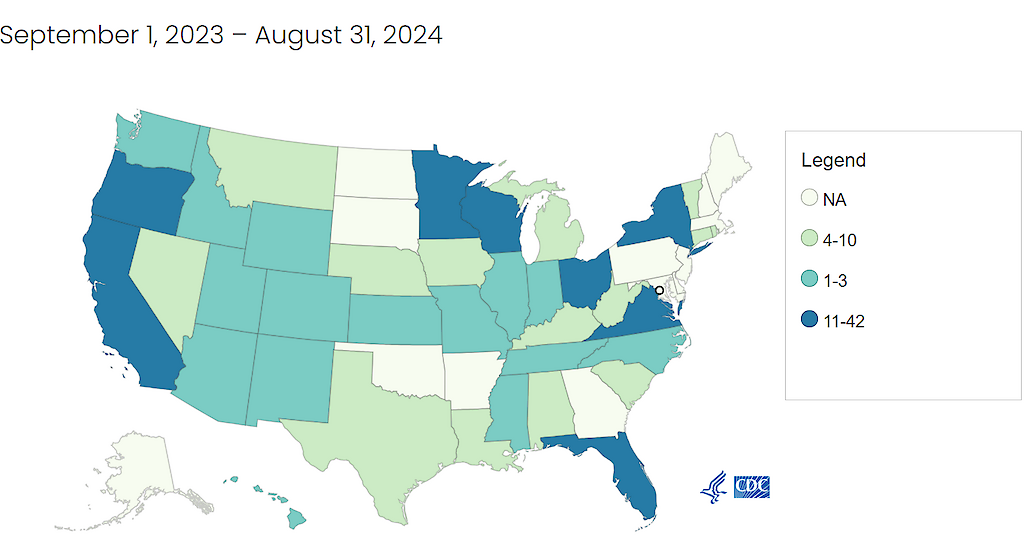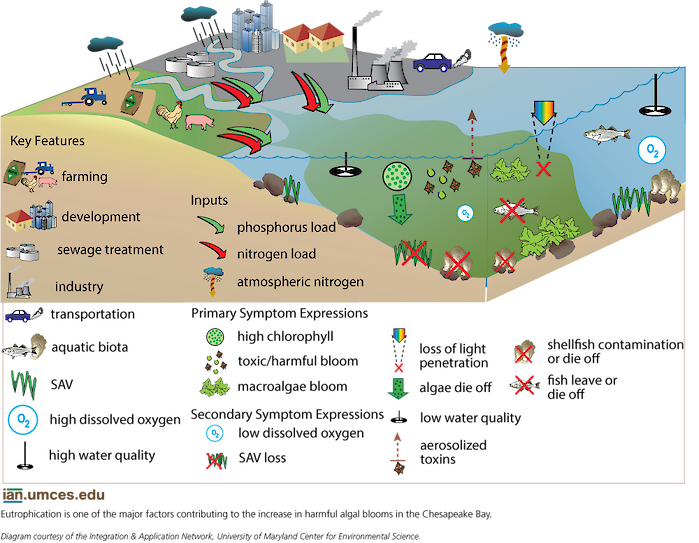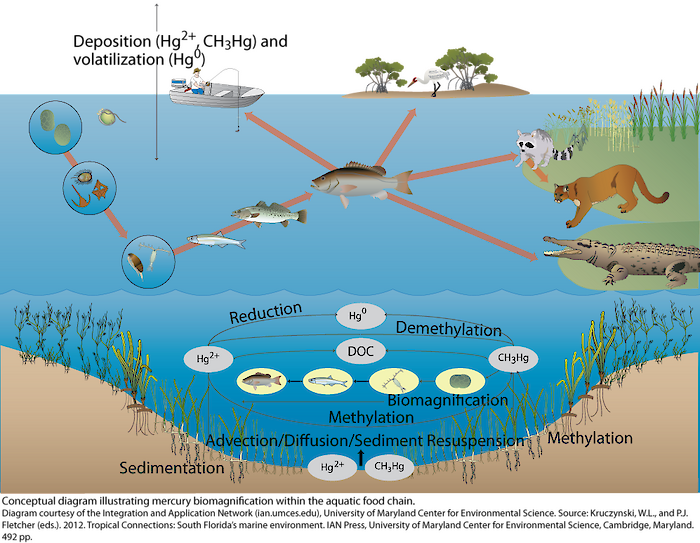We eat from where we dump
Jun Suk Byun ·Let’s take a step back and think about how we sustain our daily lives. Food comes from the field and livestock. Almost everything we use is from industrial production. What is left over of what we eat and have used goes to landfills and sewage. This cycle of living is so engraved into our daily lives that we are oblivious to its repercussions. Slowly but evidently, the consequences have been building up in the water that we drink and swim in. Science explains these consequences through pathogenic pollution, eutrophication, and mercury contamination.
Pathogenic pollution

Pathogenic pollution occurs through fecal bacteria input into the water. Fecal bacteria enters the water through animal waste, human waste from failed septic systems, and land-based bacteria that are washed away by precipitation. Some well known pathogens are E.Coli, Salmonella, and Norovirus, which cause gastroenteritis, salmonellosis, and typhoid fever1. These affect us through not only direct contact, but by contaminating drinking water and harvested shellfish1,2.
The Centers for Disease Control and Prevention estimates that noroviruses cause nearly 21 million cases of acute gastroenteritis annually and are the leading cause of gastroenteritis in adults in the United States. The most recent reports state that up to 13.7% of residents in the northeastern states tested positive in February, 20243. Although pathogenic pollution can be controlled through filtration and chemical disinfection, it is important that we reduce the amount of fecal input by repairing septic systems and regulating direct animal waste entering the water.

Confirmed norovirus outbreaks submitted by state (Sep 2023 - Aug 2024). Source: Centers for Disease Control and Prevention.
Eutrophication

Eutrophication is caused by excess nutrient (nitrogen and phosphorus) input into the water and leads to the proliferation of chlorophyll and harmful algal blooms (HABs). While HABs indirectly endanger human health through fish and shellfish poisoning, they also jeopardize biodiversity. By blocking the sunlight entering into the water, HABs inhibit the growth of submerged aquatic vegetation, which in return, limits the underwater oxygen available to aquatic life.
A close example would be the Chesapeake Bay. Over the last 60 years, the population in the Chesapeake Bay watershed has doubled, precipitating a huge increase in nutrient and sediment runoff from agricultural and urban lands4. During this process, tens of thousands of hectares of submersed aquatic vegetation were decimated due to insufficient oxygen from excessive nutrient input5. To tackle this issue and restore water quality, the EPA has been making efforts to restore clean water since 2010 by setting limits on nutrient and sediment inputs. Despite the extensive efforts, it is unclear when we can finally say the water in the bay is clean. Until then, eutrophication will continue to threaten aquatic ecosystems and people living within the watershed.

Harmful algal blooms in the Potomac river. Source: USEPA.
Mercury contamination

Mercury enters the water through atmospheric deposition from coal-fired power plants and through direct discharge of industrial wastes. After methylation in the water, it transforms into the toxic methylmercury which can deteriorate the nervous system, disrupt muscle movement, impair vision and hearing, and corrode skin. The real hazard of mercury is in that it travels up the food pyramid, contaminating algae, fish, and ultimately humans.
The Amazon is a representative region suffering from mercury contamination. With gold mining activities in the Amazon increasing by 500% over the last 15 years6, the mean level of mercury in human hair in the whole region has exceeded 6 µg/g, surpassing tolerance levels7. Anthropogenic activities have led us to a point where we can not avoid mercury completely while consuming seafood. However, the FDA and EPA does provide guidelines for healthy consumption of fish so that we can make food decisions to avoid mercury poisoning.

Mercury levels by fish. Source: Poster by FDA and EPA
Sources:
- McKee, A. M., & Cruz, M. A. (2021). Microbial and viral indicators of pathogens and human health risks from recreational exposure to waters impaired by fecal contamination. Journal of Sustainable Water in the Built Environment, 7(2), 03121001.
- Wittman, R. J., & Flick, G. J. (1995). Microbial contamination of shellfish: prevalence, risk to human health, and control strategies. Annual Review of Public Health, 16(1), 123-140.
- Food Safety News (2024). https://www.foodsafetynews.com/2024/02/norovirus-sweeps-the-country-cdc-says-northeast-particularly-hard-hit/
- RJ Orth, et al., Submersed aquatic vegetation in Chesapeake Bay: Sentinel species in a changing world. Bioscience 67, 698–712 (2017).HK Lotze, M Coll, AM Magera, C Ward-Paige, L Airoldi, Recovery of marine animal populations and ecosystems. Trends Ecol Evol 26, 595–605 (2011).
- RJ Orth, KA Moore, Chesapeake Bay: An unprecedented decline in submerged aquatic vegetation. Science 222, 51–53 (1983).
- Galvis, S. R. (2020). The Amazon Biome in the face of Mercury Contamination. WWF Gaia Amaz, 168.
- Martoredjo, I., Calvão Santos, L. B., Vilhena, J. C. E., Rodrigues, A. B. L., de Almeida, A., Sousa Passos, C. J., & Florentino, A. C. (2024). Trends in Mercury Contamination Distribution among Human and Animal Populations in the Amazon Region. Toxics, 12(3), 204.
About the author
Jun Suk Byun

Jun Suk Byun is a PhD student in the UMCES Appalachian Lab working with Dr. Xin Zhang. He is studying how the agri-food system affects the water quality in the Chesapeake Bay.
Next Post > Hot cities, Cool solutions: Exploring the Urban Heat Island Effect
Comments
-
Alison Novara 1 year ago
Wow! This blog was super informative and well thought out. Water pollution is definitely a hard topic to cover, but your use of real-life examples to follow each different driver, such as the Chesapeake Bay and the Amazon, really helped to solidify these impacts. The short thought experiment at the beginning really helped to draw me in too. Excellent graphics as well!
-
Adetutu Adebayo 1 year ago
Thank you for the write-up. Eutrophication must be prevented at all costs.
-
Taylor Breton 1 year ago
Great blog post! I really liked the use of graphics, it was really helpful.
-
Ronita 1 year ago
I like how your blog highlights the detrimental impacts of human activities on water systems, emphasizing issues such as pathogenic pollution, eutrophication, and mercury contamination. It effectively outlines the sources of contamination that range from animal waste to industrial emissions—and their serious health and environmental consequences. By linking these issues to real-world examples like the Chesapeake Bay and the Amazon, your blog brings attention to the long-term effects of pollution and the ongoing challenges in mitigating them despite restoration efforts. It encourages reflection on how everyday practices contribute to these problems and stresses the importance of sustainable solutions. Great job!
-
Ian Kalama 1 year ago
This blog provides a thorough and thought-provoking analysis of the often-overlooked consequences of our daily consumption and waste cycles, particularly their impact on water quality. Also, the inclusion of actionable steps, such as repairing septic systems and following fish consumption guidelines, makes it a practical call to action for both policymakers and individuals. Nice blog!

